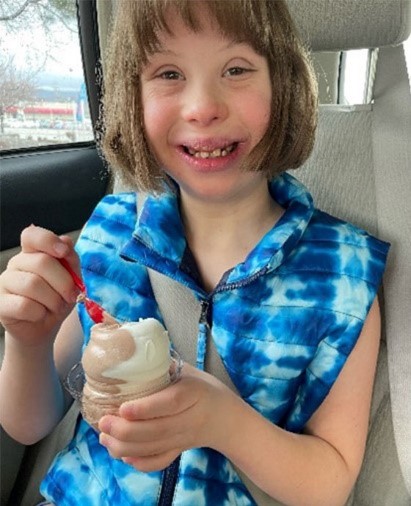Fostering Kenley’s Financial Future: A Parent’s Perspective
The doctor said, “it’s a girl.” My husband and I both smiled at each other. Later, the pediatrician joined our bedside to explain that our daughter was born with Down syndrome. That was 14 years ago.
At the time, we had no idea what that diagnosis meant or what our lives would look like from that day forward. Then again, does anyone really know what their future lives will look like? No. The only thing we knew was that we had a daughter to love.
Part of parenting is planning for a child’s financial future, whether that child has a disability or not. But for children with disabilities, there are additional factors to consider. During National Financial Literacy Month in April, I’m reminded of the importance of this—and thankful for resources available to us as we navigate this journey.
We knew we had to start early. We asked ourselves what financial resources it would take to ensure she is ready to work one day, and how we can expose her to different job opportunities that will allow her to be as independent as possible. All parents want this for their children; we just had to think about it in the context of Kenley’s abilities and the fact that one day she might not find it as fun to live with her parents as she does today—until she realizes a secret Mom fairy sometimes helps finish her chores, that is!
To start, when Kenley entered kindergarten, we purchased a pre-paid tuition plan. At that time, we honestly had no idea if she could or would want to go to college or attend a post-secondary program. However, we have high expectations and strongly believe in opening doors for her and talking to her about her dreams for the future. Some days, she wants to be a fashion designer. In fact, you can often find her cutting fabrics and placing them on a form. She proudly shows off her designs and models her favorite dresses. Other days, she wants to be just like her favorite bus driver and drive a school bus. As it is for all children, letting her explore her future dreams is important to figuring out her path to independence.
As part of this, we support and encourage Kenley to have her own voice and agency in choices. That, most decidedly, includes her future job. She wants to live on her own and carry a purse with her own money in it. She recognizes that will happen when she is gainfully employed. So, we focus on preparing her for competitive integrated employment by ensuring she can successfully communicate with her peers, express her desires and concerns, and follow through with presented tasks. And when she is a little bit older, we will make sure that she, like other teenagers, has the opportunity to engage in work-based experiences to gain important job skills.
As we work with her to plan, an important tool in our tool chest is Secure Your Financial Future: A Toolkit for Individuals with Disabilities, a resource developed by the U.S. Department of Labor’s Office of Disability Employment Policy (ODEP), Employee Benefits Security Administration (EBSA) and Employment and Training Administration (ETA). So far, we’ve used the toolkit to plan and guide conversations about Kenley’s future participation in the workforce. Some of our favorite parts of the toolkit’s Preparing for a Job section are Map Your Money Journey and the Saving Fitness Guide.
We know that Kenley needs a certain level of financial acumen to manage her money. Mapping her money journey gives Kenley insights about how much money she can expect to earn in her desired career path, her expected expenses, the amount of money she is likely to have in her Achieving a Better Life Experience (ABLE) account when she enters the workforce and her public benefits. We opened an ABLE account for Kenley as soon as it was available in Nevada. We chose it because, as an adult, it will give her financial agency—a sense of personal empowerment over her money. She can choose to use the funds in the ABLE account to support herself and enhance her life without jeopardizing her means-tested benefits.
When I talk to other parents of children with disabilities about ABLE accounts, they always ask, “Why haven’t I heard about this before?” Their second question is usually: “How do I set this up?” Our family is happy to share our story and knowledge of ABLE accounts because we are all stronger together. As part of this conversation, I also tell parents about the Secure Your Financial Future toolkit.
I know we’re not alone in wanting our daughter to have a bright financial future, so we want all parents of children with disabilities to know about the tools and resources available to help them prepare for and enter the world of work. We feel lucky these tools are available to support Kenley as she steps closer and closer to her dream job—and becoming a proud, contributing member of the workforce and community.
About the Author
Jennifer (Jenny) Casselman’s daughter, Kenley, is a seventh grader who just turned 14 years old. Kenley loves her dog Baxter, rock-climbing, baking, painting rocks, playing games with her parents and friends, and dancing. Kenley’s mom Jenny is fun too, but she also has more practical concerns when it comes to her daughter. This is why Jenny opened an ABLE account for Kenley with the Nevada ABLE program years ago. This allows Kenley, who has Down syndrome, to save and prepare for her future, while supporting her independence.
Jenny is also an ABLE National Resource Center (ABLE NRC) Ambassador Alumni. The ABLE NRC is the leading source of objective, independent information, and best practices related to tax-advantaged ABLE savings accounts and federal and state-related ABLE programs and activities.

